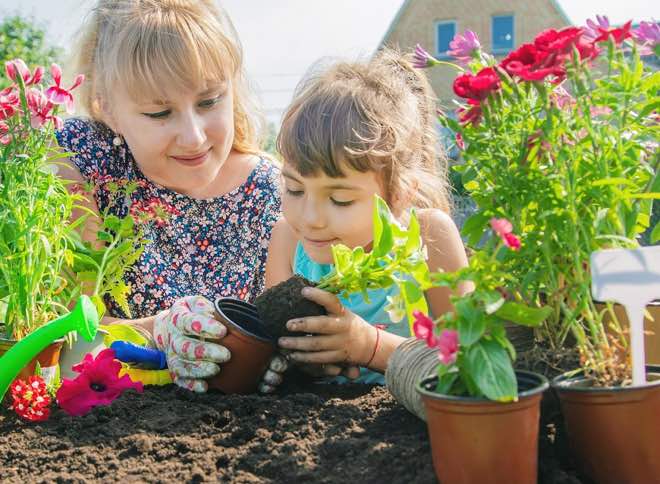Spring is already pushing its way out whether you are ready for it or not! I am definitely ready to welcome the birds, the buds, and the scent of freshly turned earth back again. And if you’re like me, you’re anxious to get your garden started. This year, is it time to get the kids gardening, too? The benefits of getting your kids involved in the garden are numerous and worth the extra effort.
Whether you are growing fruits and veggies, or attracting birds and butterflies with beautiful flowers, your garden provides the setting for a fun learning experience for children.
Gardening Benefits
What makes gardening so beneficial? Here are a few ways I think kids benefit from gardening.

Healthier Food
One of the first and most obvious benefits is that you are letting your child help you provide the family with food that is not only healthy and nourishing, but unlike most supermarket produce, you can control and keep the pesticides and other chemicals out of it. Got a picky eater? A child who works in the garden is much more likely to try foods that they have had a part in growing.
Sunshine
Oh, the benefits of sunshine and fresh air! You’ll notice your young garden assistants sporting healthy pink cheeks, sparkling eyes, and a hearty appetite. The sun offers generous helpings of good old Vitamin D. Children sleep better with adequate levels of vitamin D; it also boosts their immunity and strengthens bones.
Pride
Give children their own small area to tend, be it a spot in your garden or a container. Watching something they planted and tended grow and mature gives a child a great sense of pride and accomplishment. It also helps them understand where their food comes from; a lot of kids think that the veggies on their plate comes straight from the grocery store. Helping in the garden will give them an appreciation for the food that they eat and the work that goes into it.
Memories
Build amazing memories and lifelong bonding moments with your child as you dig, mulch, and taste the fruit of your labors. Your child will long and fondly remember the times you spent together in the garden working, even if all you had to show for it was a couple scraggly carrots and a giant radish.
Observing Nature
Beyond the benefits of learning about tending a garden, there is no better classroom for a child than nature. At any given moment, they can investigate soil, trees, bugs, weather, birds, butterflies, bees, ants, or a million other things. Gardening puts children right in the center of a bright and interesting world that they will naturally crave to know more about.
Rich Learning Experience
Looking for gardening tips for homeschooling? You can easily turn gardening into a lesson in writing, math, spelling, and critical thinking.
Older children can draw a diagram of your garden plot, deciding what to put where, research what is best grown together and what should never be grown together, make a list of the seeds you need, and make handmade garden markers. Let your child research your growing zoneand decide what grows best there.
Take a sample of your soil to your local extension office where they will test it and tell you what it needs or what needs to be cut down for success. Kids will find this process fascinating and can also help you amend the soil with natural products.
Children learn all these things and more in the garden:
- Self confidence
- Nutrition
- Planning
- Reasoning
- Responsibility
- Nature discovery
- Cause and effect
Tips for Helping Kids Garden
Once you get the kids in the garden, where do you start? And how do you keep them engaged and excited about digging in the dirt?
- Tools: Start by getting your children some tools of their very own. Teach them how to care for and store the tools. A small tote, gloves, a trowel, and hand rake are good basic pieces. Giving them ownership will give them confidence in their own abilities. And child-sized tools are easier — and safer — for kids to handle.
- Plants: Next, let them make some of the choices on what to plant. This helps give them a sense of ownership and responsibility for the garden. You want the kids to succeed, so suggest plants that have a high success rate and are easy to grow. Some plants that are fairly easy to grow include peas, radishes, cabbage, sunflowers, potatoes, strawberries, and pumpkins. Decide whether to start from seeds or plants. I like to grow almost everything from seeds; it’s fun for children to see the process from seed to mature plant.
- Jobs: Give them jobs like watering, mixing soil, weeding (after you have demonstrated), planting, harvesting, fertilizing, re-potting plants, mulching, stirring the compost, and fertilizing. Work together to plant, care for, and harvest your bounty.
- Fun: Finally, to keep their attention, add fun little vignettes and whimsy in or near the garden. Some fun ideas are a small fairy garden tucked in among the cabbages, a pretty bird bath to attract backyard birds, a shady spot to sit and watch, fun garden markers, or brightly painted garden gnomes.
Garden Safety Tips for Kids
Before we close, let’s look at some gardening safety tips for your child.
- Teach your child to use and store tools safely.
- Keep chemical sprays and fertilizers locked away (or better yet, don’t use them at all).
- Apply a natural sunscreen before going out and throughout the day.
- Wear sun hats and sunglasses.
- Stay hydrated with water for everyone!
- Empty all watering cans and buckets when done to discourage mosquitoes from laying eggs.
The post Gardening Tips: How To Get Kids Involved appeared first on Earth911.








